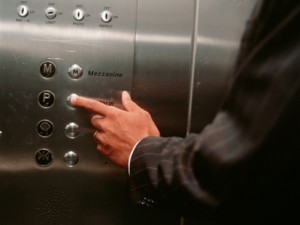 By Thomas Storck
By Thomas Storck
The scene: You’re sitting in an office to which you’d been invited to a week prior for a job interview, waiting to meet your potential future employer face-to-face. Your interviewer arrives to greet you, shakes your hand, and directs you through a short hallway to her office. As you hang your coat across an adjacent chair and open your bag to remove copies of your resume, you try to anticipate her first question so as to make a good first impression at the beginning of the interview.

But it’s too late.
According to communication coach Pam Berns, it takes only 30 seconds to make a first impression (by conservative estimates). More often than we think, we could be reaching that deadline before having a chance to say anything at all! It follows, then, that if we acknowledge the power of a first impression then we must equally acknowledge the power of our body language. The latter’s power hinges on two ideas – consciously or not, we are 1) constantly sending messages and 2) constantly judging others.
How can we make a good first impression, if not verbally, in a situation like the hypothetical scenario described above? For one thing, keep in mind that a strong handshake communicates power and gives you an opportunity to respond similarly if you meet an interviewer with one of those “power grips”. Also, be sure to use direct eye contact to communicate confidence. Remember, there’s a reason the police have long used eye contact as a way to judge a suspect’s honesty.
Below are a few examples to get us thinking about how we send messages with our bodies:

Bill Clinton communicates power here in at least two ways: the way he looks down at his audience over his reading glasses and the way he points with his finger. (But be cautious; finger pointing is typically inappropriate, even rude, for the average job-seeker.)

Michelle Obama wears a sleeveless dress, and it’s easy to see why. Her muscular arms communicate strength. But when she combines it with her open posture, we get a message from her that says she’s powerful, but also welcoming and approachable.

But as we can see, with a slight variation in posture, the appearance of openness can quickly turn into defensiveness.
Power and Approachability
Once you recognize how you may be communicating with your body language, you can use these techniques consciously to send specific messages, says Berns. It may be in your interest at times to appear powerful, commanding and confident, but at other times soft, open and approachable. Often, it may be most effective to use techniques from both sides, or move strategically along the spectrum. Berns makes it easy to remember these various non-verbal techniques by sorting them into two categories: the pen (angular, hard, quick, solid, overt) and the brush (flowing, soft, slow, fluid, multidirectional). The pen represents the more commanding side and the brush, more approachable. You can apply this model to all aspects of communication from posture to gesture to voice.
During an interview, it’s usually a good rule of thumb to match your interviewer’s gestures. “If you’re like them, they like you,” says Berns about the importance of using body language to build rapport. This bias may not be obvious, but is almost certainly happening unconsciously on some level.
Size Matters
Often, there will be circumstances beyond your control that may automatically give one person an advantage over the other, such as height difference. A taller person might appear to have an advantage simply by virtue of size, but that’s not to say the shorter of the two can’t gain an edge. Sitting up straight and maintaining eye contact are two ways to communicate confidence and to gain power in any situation. On the other hand, if, while in an authoritative position, you want to come across as approachable and put others at ease, you can physically move closer to their level by sitting down or leaning on a desk, rather than standing up.
Manage Your Voice
It’s also important to consider the volume of your voice. Too soft a voice can communicate a lack of confidence, but a voice that’s too loud isn’t much better. Our voices are tied closely to our self-image and we may hear our own voices differently than others do, says Berns. You should match your voice level to that of your interviewer’s, but to know how your voice sounds to others, Berns offers the following exercise, which you can do with a friend or colleague: After a brief conversation, have each you and your partner rate your own voice level on a scale of 1 to 10. If your partner’s number is lower than yours (ex. you might think you’re at about a 6, but they’re hearing about a 4), then you may sound softer than you think to other people and should try to speak louder when trying to match the voice level of others.
 Personal Space
Personal Space
Watch what happens the next time a crowd piles into an elevator or subway car. Most likely, everyone will be doing the same thing you are: protecting his or her own kinesphere. “Kinesphere” is a term Berns uses to describe personal space. Specifically, it refers to the area around your body that can be defined by fully extending your arms, and can be a powerful tool when controlling the relationship between you and your interviewer. If you begin to lose confidence during an interview, you can reclaim power by moving slightly forward into the other person’s kinesphere. This technique can also be used to express interest, especially in a situation where you’re asked a tough question. Taking the time to move forward can also buy you some time while allowing you to reclaim some of the confidence you may have lost while you searched for your answer.

On a similar note, be conscious of where you place your hands. Keeping them under the table can make it look like you’re hiding something. Placing your hands on the table also allows you to push them slightly forward into the other person’s kinesphere, if needed. But be careful – manipulating kinespheres can easily come across as too aggressive, or “pen-like”, so consider doing something “brush-like” to maintain a comfortable dynamic.
Watch What You Wear
Keep in mind that clothing matters when you want to make a good impression. If there’s any question about what’s appropriate to wear for an interview, or really any more-than-casual situation, it never hurts to ask. Outside of an interview situation, it might be worth keeping in mind that you never know who you’ll meet, says Berns, so dressing well for any potentially career-related event can have rewarding results.
Skype Interviews
Skype has its own set of rules, so Berns offers some extra tips for managing nonverbal messages in a Skype interview:
Framing – If you decide to dress formally from the waist up only, be sure to frame your screen accordingly
Background – Make sure there’s not too much going on behind your head. You don’t want to distract your interviewer or unintentionally give away personal secrets. But try to avoid sitting in front of a boring, blank wall – “you don’t want to look like you’re sitting in an interrogation room either.”
Angle – No one wants to see your whole body during a Skype interview – your head and upper torso are just fine
What You See is What You Get

Many of the these techniques can be equally useful in communication situations other than job interviews. No matter what the situation, says Berns, “What you see is what you get.” The key is to make conscious decisions about what you are communicating, so you don’t accidentally send the wrong message. Remember, you are always communicating something– whether you know it or not.
 By Thomas Storck
The scene: You’re sitting in an office to which you’d been invited to a week prior for a job interview, waiting to meet your potential future employer face-to-face. Your interviewer arrives to greet you, shakes your hand, and directs you through a short hallway to her office. As you hang your coat across an adjacent chair and open your bag to remove copies of your resume, you try to anticipate her first question so as to make a good first impression at the beginning of the interview.
By Thomas Storck
The scene: You’re sitting in an office to which you’d been invited to a week prior for a job interview, waiting to meet your potential future employer face-to-face. Your interviewer arrives to greet you, shakes your hand, and directs you through a short hallway to her office. As you hang your coat across an adjacent chair and open your bag to remove copies of your resume, you try to anticipate her first question so as to make a good first impression at the beginning of the interview. But it’s too late.
According to communication coach Pam Berns, it takes only 30 seconds to make a first impression (by conservative estimates). More often than we think, we could be reaching that deadline before having a chance to say anything at all! It follows, then, that if we acknowledge the power of a first impression then we must equally acknowledge the power of our body language. The latter’s power hinges on two ideas – consciously or not, we are 1) constantly sending messages and 2) constantly judging others.
How can we make a good first impression, if not verbally, in a situation like the hypothetical scenario described above? For one thing, keep in mind that a strong handshake communicates power and gives you an opportunity to respond similarly if you meet an interviewer with one of those “power grips”. Also, be sure to use direct eye contact to communicate confidence. Remember, there’s a reason the police have long used eye contact as a way to judge a suspect’s honesty.
Below are a few examples to get us thinking about how we send messages with our bodies:
But it’s too late.
According to communication coach Pam Berns, it takes only 30 seconds to make a first impression (by conservative estimates). More often than we think, we could be reaching that deadline before having a chance to say anything at all! It follows, then, that if we acknowledge the power of a first impression then we must equally acknowledge the power of our body language. The latter’s power hinges on two ideas – consciously or not, we are 1) constantly sending messages and 2) constantly judging others.
How can we make a good first impression, if not verbally, in a situation like the hypothetical scenario described above? For one thing, keep in mind that a strong handshake communicates power and gives you an opportunity to respond similarly if you meet an interviewer with one of those “power grips”. Also, be sure to use direct eye contact to communicate confidence. Remember, there’s a reason the police have long used eye contact as a way to judge a suspect’s honesty.
Below are a few examples to get us thinking about how we send messages with our bodies:
 Bill Clinton communicates power here in at least two ways: the way he looks down at his audience over his reading glasses and the way he points with his finger. (But be cautious; finger pointing is typically inappropriate, even rude, for the average job-seeker.)
Bill Clinton communicates power here in at least two ways: the way he looks down at his audience over his reading glasses and the way he points with his finger. (But be cautious; finger pointing is typically inappropriate, even rude, for the average job-seeker.)
 Michelle Obama wears a sleeveless dress, and it’s easy to see why. Her muscular arms communicate strength. But when she combines it with her open posture, we get a message from her that says she’s powerful, but also welcoming and approachable.
Michelle Obama wears a sleeveless dress, and it’s easy to see why. Her muscular arms communicate strength. But when she combines it with her open posture, we get a message from her that says she’s powerful, but also welcoming and approachable.
 But as we can see, with a slight variation in posture, the appearance of openness can quickly turn into defensiveness.
Power and Approachability
Once you recognize how you may be communicating with your body language, you can use these techniques consciously to send specific messages, says Berns. It may be in your interest at times to appear powerful, commanding and confident, but at other times soft, open and approachable. Often, it may be most effective to use techniques from both sides, or move strategically along the spectrum. Berns makes it easy to remember these various non-verbal techniques by sorting them into two categories: the pen (angular, hard, quick, solid, overt) and the brush (flowing, soft, slow, fluid, multidirectional). The pen represents the more commanding side and the brush, more approachable. You can apply this model to all aspects of communication from posture to gesture to voice.
During an interview, it’s usually a good rule of thumb to match your interviewer’s gestures. “If you’re like them, they like you,” says Berns about the importance of using body language to build rapport. This bias may not be obvious, but is almost certainly happening unconsciously on some level.
Size Matters
But as we can see, with a slight variation in posture, the appearance of openness can quickly turn into defensiveness.
Power and Approachability
Once you recognize how you may be communicating with your body language, you can use these techniques consciously to send specific messages, says Berns. It may be in your interest at times to appear powerful, commanding and confident, but at other times soft, open and approachable. Often, it may be most effective to use techniques from both sides, or move strategically along the spectrum. Berns makes it easy to remember these various non-verbal techniques by sorting them into two categories: the pen (angular, hard, quick, solid, overt) and the brush (flowing, soft, slow, fluid, multidirectional). The pen represents the more commanding side and the brush, more approachable. You can apply this model to all aspects of communication from posture to gesture to voice.
During an interview, it’s usually a good rule of thumb to match your interviewer’s gestures. “If you’re like them, they like you,” says Berns about the importance of using body language to build rapport. This bias may not be obvious, but is almost certainly happening unconsciously on some level.
Size Matters Often, there will be circumstances beyond your control that may automatically give one person an advantage over the other, such as height difference. A taller person might appear to have an advantage simply by virtue of size, but that’s not to say the shorter of the two can’t gain an edge. Sitting up straight and maintaining eye contact are two ways to communicate confidence and to gain power in any situation. On the other hand, if, while in an authoritative position, you want to come across as approachable and put others at ease, you can physically move closer to their level by sitting down or leaning on a desk, rather than standing up.
Manage Your Voice
It’s also important to consider the volume of your voice. Too soft a voice can communicate a lack of confidence, but a voice that’s too loud isn’t much better. Our voices are tied closely to our self-image and we may hear our own voices differently than others do, says Berns. You should match your voice level to that of your interviewer’s, but to know how your voice sounds to others, Berns offers the following exercise, which you can do with a friend or colleague: After a brief conversation, have each you and your partner rate your own voice level on a scale of 1 to 10. If your partner’s number is lower than yours (ex. you might think you’re at about a 6, but they’re hearing about a 4), then you may sound softer than you think to other people and should try to speak louder when trying to match the voice level of others.
Often, there will be circumstances beyond your control that may automatically give one person an advantage over the other, such as height difference. A taller person might appear to have an advantage simply by virtue of size, but that’s not to say the shorter of the two can’t gain an edge. Sitting up straight and maintaining eye contact are two ways to communicate confidence and to gain power in any situation. On the other hand, if, while in an authoritative position, you want to come across as approachable and put others at ease, you can physically move closer to their level by sitting down or leaning on a desk, rather than standing up.
Manage Your Voice
It’s also important to consider the volume of your voice. Too soft a voice can communicate a lack of confidence, but a voice that’s too loud isn’t much better. Our voices are tied closely to our self-image and we may hear our own voices differently than others do, says Berns. You should match your voice level to that of your interviewer’s, but to know how your voice sounds to others, Berns offers the following exercise, which you can do with a friend or colleague: After a brief conversation, have each you and your partner rate your own voice level on a scale of 1 to 10. If your partner’s number is lower than yours (ex. you might think you’re at about a 6, but they’re hearing about a 4), then you may sound softer than you think to other people and should try to speak louder when trying to match the voice level of others.
 Personal Space
Watch what happens the next time a crowd piles into an elevator or subway car. Most likely, everyone will be doing the same thing you are: protecting his or her own kinesphere. “Kinesphere” is a term Berns uses to describe personal space. Specifically, it refers to the area around your body that can be defined by fully extending your arms, and can be a powerful tool when controlling the relationship between you and your interviewer. If you begin to lose confidence during an interview, you can reclaim power by moving slightly forward into the other person’s kinesphere. This technique can also be used to express interest, especially in a situation where you’re asked a tough question. Taking the time to move forward can also buy you some time while allowing you to reclaim some of the confidence you may have lost while you searched for your answer.
Personal Space
Watch what happens the next time a crowd piles into an elevator or subway car. Most likely, everyone will be doing the same thing you are: protecting his or her own kinesphere. “Kinesphere” is a term Berns uses to describe personal space. Specifically, it refers to the area around your body that can be defined by fully extending your arms, and can be a powerful tool when controlling the relationship between you and your interviewer. If you begin to lose confidence during an interview, you can reclaim power by moving slightly forward into the other person’s kinesphere. This technique can also be used to express interest, especially in a situation where you’re asked a tough question. Taking the time to move forward can also buy you some time while allowing you to reclaim some of the confidence you may have lost while you searched for your answer.
 On a similar note, be conscious of where you place your hands. Keeping them under the table can make it look like you’re hiding something. Placing your hands on the table also allows you to push them slightly forward into the other person’s kinesphere, if needed. But be careful – manipulating kinespheres can easily come across as too aggressive, or “pen-like”, so consider doing something “brush-like” to maintain a comfortable dynamic.
Watch What You Wear
Keep in mind that clothing matters when you want to make a good impression. If there’s any question about what’s appropriate to wear for an interview, or really any more-than-casual situation, it never hurts to ask. Outside of an interview situation, it might be worth keeping in mind that you never know who you’ll meet, says Berns, so dressing well for any potentially career-related event can have rewarding results.
Skype Interviews
Skype has its own set of rules, so Berns offers some extra tips for managing nonverbal messages in a Skype interview:
Framing – If you decide to dress formally from the waist up only, be sure to frame your screen accordingly
Background – Make sure there’s not too much going on behind your head. You don’t want to distract your interviewer or unintentionally give away personal secrets. But try to avoid sitting in front of a boring, blank wall – “you don’t want to look like you’re sitting in an interrogation room either.”
Angle – No one wants to see your whole body during a Skype interview – your head and upper torso are just fine
What You See is What You Get
On a similar note, be conscious of where you place your hands. Keeping them under the table can make it look like you’re hiding something. Placing your hands on the table also allows you to push them slightly forward into the other person’s kinesphere, if needed. But be careful – manipulating kinespheres can easily come across as too aggressive, or “pen-like”, so consider doing something “brush-like” to maintain a comfortable dynamic.
Watch What You Wear
Keep in mind that clothing matters when you want to make a good impression. If there’s any question about what’s appropriate to wear for an interview, or really any more-than-casual situation, it never hurts to ask. Outside of an interview situation, it might be worth keeping in mind that you never know who you’ll meet, says Berns, so dressing well for any potentially career-related event can have rewarding results.
Skype Interviews
Skype has its own set of rules, so Berns offers some extra tips for managing nonverbal messages in a Skype interview:
Framing – If you decide to dress formally from the waist up only, be sure to frame your screen accordingly
Background – Make sure there’s not too much going on behind your head. You don’t want to distract your interviewer or unintentionally give away personal secrets. But try to avoid sitting in front of a boring, blank wall – “you don’t want to look like you’re sitting in an interrogation room either.”
Angle – No one wants to see your whole body during a Skype interview – your head and upper torso are just fine
What You See is What You Get
 Many of the these techniques can be equally useful in communication situations other than job interviews. No matter what the situation, says Berns, “What you see is what you get.” The key is to make conscious decisions about what you are communicating, so you don’t accidentally send the wrong message. Remember, you are always communicating something– whether you know it or not.
Many of the these techniques can be equally useful in communication situations other than job interviews. No matter what the situation, says Berns, “What you see is what you get.” The key is to make conscious decisions about what you are communicating, so you don’t accidentally send the wrong message. Remember, you are always communicating something– whether you know it or not.
Leave a Reply
You must be logged in to post a comment.